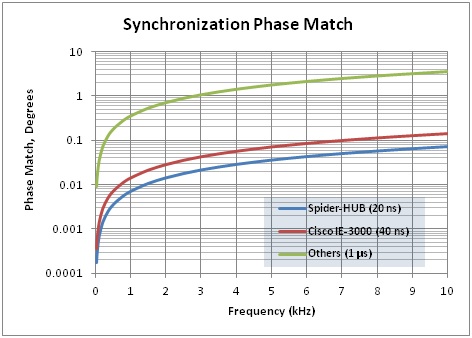Industrial Ethernet Switches for Spider Systems
Download PDF | © Copyright Crystal Instruments 2016, All Rights Reserved.
Crystal Instruments’ Spider platform uses 100 mbps Ethernet for data transfer and synchronization. Although Spider front-ends can work with any standard Ethernet switch, some switches will have better performance than others. Specifically, switches with support for IEEE 1588 Precision Time Protocol (PTP) version 2 will allow significantly higher synchronization performance than switches that lack PTP support. For the best performance, Crystal Instruments’ own Spider-HUB should be used. The IE 3000 series industrial switches by Cisco also support PTP and can be used for high-precision synchronization. A Spider system with multiple modules uses PTP to synchronize the internal clocks of each module over the Ethernet network so that all input channels can be accurately phase-matched. Each module is connected to a central switch that routes messages from each connected module through its ports. PTP synchronization will work regardless of whether the switch is PTP-enabled or not. PTP works by measuring the signal path delay between each module, and the more precisely this delay can be measured and predicted the more accurately the clocks can be synchronized. With a regular, non-PTP switch, the delay through the switch can vary greatly depending on the network load. This adds an unknown variable into the PTP delay calculation and limits the accuracy of the clock synchronization. PTP-enabled switches dramatically improve the ability of the PTP protocol to estimate delay, and, therefore, increase the precision to which the clocks can be synchronized.
It is important to note the distinction between Ethernet “switches” and a “hubs”. Hubs are largely obsolete and work by blindly broadcasting transmissions received on one port to every other port. They rely on collision detection among the connected Ethernet devices themselves to allow multiple devices to communicate. Switches, in contrast, use a store-and-forward mechanism to transfer a transmitted packet from one device only to the port (or ports, for multicast messages) of the intended recipient. Switches can handle larger amounts of traffic more reliably and are more desirable to use than hubs.
Spider-HUB
The Spider-HUB is an advanced, managed Ethernet switch (not a hub, despite its name) manufactured by Crystal Instruments. It is designed for the Spider platform, fully supports PTP, and can achieve a synchronization precision of 20 ns with up to 8 Spider modules. In fact, it is the only switch that can synchronize Spider modules this accurately.
Because it is PTP-enabled, it is aware of which ports are part of the PTP sync domain and which are not. It can then isolate the PTP multicast messages and prevent external traffic from interfering with the synchronization.
Cisco IE3000
The Cisco IE 3000 Series are also PTP-enabled managed Ethernet switches that work with the Spider platform. Their performance is not as good as the Spider-HUB, but they can still achieve synchronization within 40 nanoseconds with up to 8 Spiders. A drawback of these switches is that they require a special power supply, and they are also bulky and less power efficient.
Non-PTP Switches
The Spider system can work with any Ethernet switch even if it is not PTP-enabled. Synchronization, however, will not be as accurate. With two Spider modules, synchronization is within about 1 microsecond. Adding more modules, and interference from external network traffic, will significantly degrade this performance.
For any Spider system, it is recommended to use a separate network that is not shared with other hosts or services (i.e. separate from an office LAN). For reliability and performance reasons external traffic not related to the data acquisition should be eliminated as much as possible. Also, for any system with more than two modules, only the Cisco IE3000 or the Spider-HUB should be used.
| Synchronization Precision | Maximum Number of Modules |
|
|---|---|---|
| Spider-HUB | 20 ns | 8 |
| Cisco IE 3000 | 40 ns | 8 |
| Others | 1 µs | 2 |



